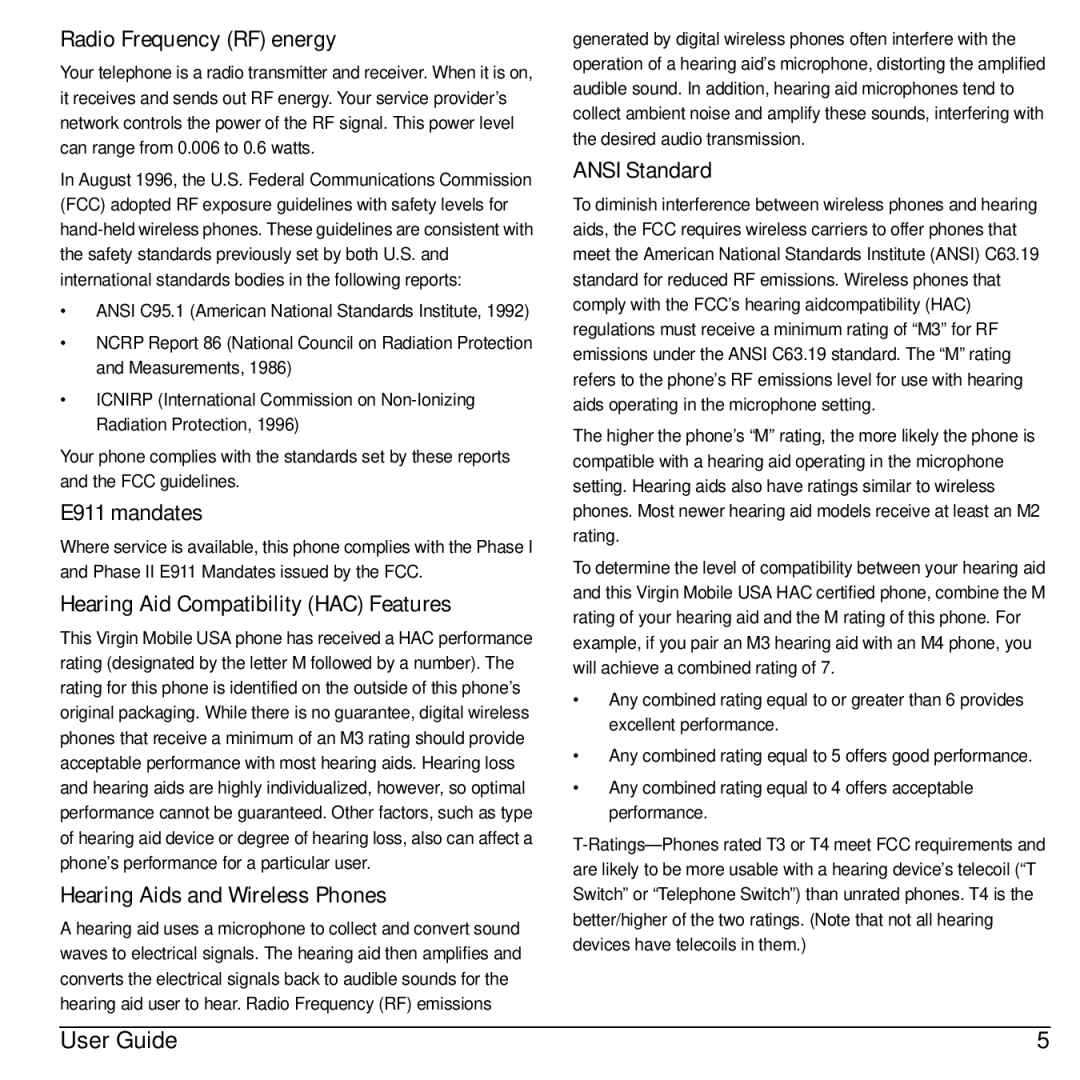Radio Frequency (RF) energy
Your telephone is a radio transmitter and receiver. When it is on, it receives and sends out RF energy. Your service provider’s network controls the power of the RF signal. This power level can range from 0.006 to 0.6 watts.
In August 1996, the U.S. Federal Communications Commission (FCC) adopted RF exposure guidelines with safety levels for
•ANSI C95.1 (American National Standards Institute, 1992)
•NCRP Report 86 (National Council on Radiation Protection and Measurements, 1986)
•ICNIRP (International Commission on
Your phone complies with the standards set by these reports and the FCC guidelines.
E911 mandates
Where service is available, this phone complies with the Phase I and Phase II E911 Mandates issued by the FCC.
Hearing Aid Compatibility (HAC) Features
This Virgin Mobile USA phone has received a HAC performance rating (designated by the letter M followed by a number). The rating for this phone is identified on the outside of this phone’s original packaging. While there is no guarantee, digital wireless phones that receive a minimum of an M3 rating should provide acceptable performance with most hearing aids. Hearing loss and hearing aids are highly individualized, however, so optimal performance cannot be guaranteed. Other factors, such as type of hearing aid device or degree of hearing loss, also can affect a phone’s performance for a particular user.
Hearing Aids and Wireless Phones
A hearing aid uses a microphone to collect and convert sound waves to electrical signals. The hearing aid then amplifies and converts the electrical signals back to audible sounds for the hearing aid user to hear. Radio Frequency (RF) emissions
User Guide
generated by digital wireless phones often interfere with the operation of a hearing aid’s microphone, distorting the amplified audible sound. In addition, hearing aid microphones tend to collect ambient noise and amplify these sounds, interfering with the desired audio transmission.
ANSI Standard
To diminish interference between wireless phones and hearing aids, the FCC requires wireless carriers to offer phones that meet the American National Standards Institute (ANSI) C63.19 standard for reduced RF emissions. Wireless phones that comply with the FCC’s hearing aidcompatibility (HAC) regulations must receive a minimum rating of “M3” for RF emissions under the ANSI C63.19 standard. The “M” rating refers to the phone’s RF emissions level for use with hearing aids operating in the microphone setting.
The higher the phone’s “M” rating, the more likely the phone is compatible with a hearing aid operating in the microphone setting. Hearing aids also have ratings similar to wireless phones. Most newer hearing aid models receive at least an M2 rating.
To determine the level of compatibility between your hearing aid and this Virgin Mobile USA HAC certified phone, combine the M rating of your hearing aid and the M rating of this phone. For example, if you pair an M3 hearing aid with an M4 phone, you will achieve a combined rating of 7.
•Any combined rating equal to or greater than 6 provides excellent performance.
•Any combined rating equal to 5 offers good performance.
•Any combined rating equal to 4 offers acceptable performance.
5
